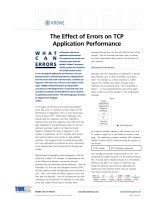Tài liệu KRONE - GUIDE - How VoIP & Active Managed Networks increase Produtivity doc
Bạn đang xem bản rút gọn của tài liệu. Xem và tải ngay bản đầy đủ của tài liệu tại đây (158.44 KB, 4 trang )
KRONE
facts
How VoIP & Active Managed Networks
Increase Productivity and Save You Money
The Way to the Future!
Structured Cabling has been evolving with
technology and the installed base expanding, for
the past 15 years. During that time it has served its
purpose well. It has proven to be a flexible
infrastructure platform on which corporate data
can be reliably transported, using every imaginable
signal type ranging from analogue voice to a wide
variety of digital protocols.
Often referred to as “level zero” in the 7 level OSI
model, structured cabling has always been about
connection flexibility and the ability to provide a
common platform for all signals. Now we are seeing
the convergence of the lower OSI levels, driven by a
universal trend towards a common layer 2 in the
form of the IEEE 802.3xx Ethernet and through the
adoption of TCP/IP at layers 3 and 4.
As a consequence of this, the demands for the
kind of physical cross-connecting flexibility that
structured cabling has had in the work area in the
past (shown in fig 1), is now becoming less
frequent. This convergence of layers 1 and 2 has
given the network manager the ability to move the
“connectivity” administration from a hardware
related cross-connect function into a software
controlled function. This has the potential to make
the work area network (shown in fig 2) much more
dynamic and flexible and lowers both cabling
equipment and installation costs as well as ongoing
maintenance costs.
What is Active Managed Structured Cabling™
(AMSC)?
AMSC is a cabling technology evolution invented by
KRONE. AMSC comes about when there is no
longer a need to manage cabling through physical
cross connects, rather, all management and
administration is done through software control.
This is realised when all user outlets in the network
are wired “active” and are managed by Simple
Network Management Protocol (SNMP). Hence
there is no ensuing need for patch fields.
AMSC is a solution option within KRONE’s
Premis
NET
®
GLOBAL LEADER
portfolio. The
GLOBAL
LEADER
portfolio is designed for both large and
small companies who are true global leaders in their
field, where the application of technology gives
them a leading and competitive edge.
VoIP and Why it Changes the Premises
Cabling Scene
Most traditional business phone networks use the
Public Switched Telephone Network (PSTN). This
system employs circuit-switched technology that
requires a dedicated voice channel to be assigned to
each particular conversation.
Today, business phone networks are on a fast
migration path to Voice over Internet Protocol, or
VoIP. This is a system where the voice signal is
digitised, compressed and packetised. This
compressed digital message no longer requires a
voice channel. Instead, digitised voice can be sent
across the same data lines that are used for the
Intranet or Internet. The message can now share
bandwidth with other voice, data and image
messages in the network and the work area.
Why Deploy VoIP?
Businesses today are demanding more from
communication technologies. They want to
communicate with their clients using voice, data
and images, all of which require increased
bandwidth. Communication networks offering this
increased bandwidth - cable networks, company
Intranets and the Internet are becoming more
popular and the cost of bandwidth is fast reducing.
Consumers also want simplification by having all
their communication services through one reliable
KRONE (Australia) Holdings Pty Limited
2 Hereford Street Berkeley Vale NSW 2261
PO Box 335 Wyong NSW 2259
Phone: 02 4389 5000
Fax: 02 4388 4499
Tech Support: 1800 801 298
Email:
Web: krone.com.au
Copyright © 2004 KRONE (Australia) Holdings Pty. Limited
Job No.: 6165 02/04
network. A converged VoIP - data network, offers
just this solution, allowing a business to use their
existing data network to make telephone calls. All
this is achieved while eliminating the costs to
sustain analogue peripherals, including the
purchase and maintenance of separate hardware
and service charges.
Quality of Service
When VoIP technology was in its infancy, there were
many problems with the quality of service when
compared to an analogue phone call. Today VoIP
technology has improved dramatically, the major
public network operators use VoIP extensively in
their own networks. A VoIP phone call over a virtual
private network (VPN) is now almost
indistinguishable from an analogue call - in fact it
has a better quality.
The Next Generation of Structured Cabling
All of this has a significant impact on premises
cabling. Structured cabling philosophy till now has
been for a wiring solution that can carry both
analogue voice and digital data signals. This was
achieved by adopting a standard topology and
cable type, which delivered each signal type over
discrete cable pairs from active equipment in the
equipment room and Floor Distributor, to the
workstation.
VoIP enables both voice and data signals to be
carried over Ethernet on layer 1 and share the same
protocol. If required, the VoIP can be
transported on the same cable pairs and the
same active equipment in the work area as
the non-voice data. With this situation the
part of the premises cable network previously
required for discrete telephony signals
becomes redundant.
The Need for Patching now Disappears
One major impact of this convergence is the
advent of networks with “all outlets active”
and the subsequent lack of need for patching
fields. For most users the primary objective in
implementing a converged solution is to
reduce the cost, delay and time taken to
implement moves and changes. VoIP
telephony uses the handset’s (or workstations)
IP address to route calls. Hence the VoIP
handset, just like a network PC, can be moved
from one workstation outlet to any other
active outlet on the network and will function
correctly with no work required apart from
the physical move. This benefit, coupled with
the continuing reduction in the cost per active
port on switches, is leading to sites being
cabled with “all outlets active”.
This is a complete turnaround in perspective
since structured cabling was first introduced
15 years ago. Then, the actives were so
expensive that patching was the only available
effective solution to manage access. Today,
the costs associated with the actives makes an
“all outlets active” solution much more viable.
With network convergence, the need to cross
connect has become less popular amongst
network administrators.
Figure 1: Typical integrated
voice and data structured
cabling installation.
What Replaces the Patch Panel in Active
Managed Structured Cabling™
With an “all outlets active” network there is no
longer a need for patch panels in the Floor
Distributor. The workstation cabling is simply
interconnected to the layer 2 switch via KRONE’s
unique high density Category 6 Ultim8
®
and
HIGHBAND
®
25 Break-Access Modules. The Break-
Access feature incorporated in the Ultim8 and
HIGHBAND 25 cable termination module provides
connection access for data circuit testing and if
required allows a means of service restoration in the
event of a switch port failure.
The advantages of this are:
Q
Less cabling equipment space is needed in
Floor Distributors and equipment rooms
Q
Fewer expensive equipment racks and
lower installation and connecting
equipment costs as a result of the
elimination of patch panels and patch cords
Q
A more reliable network due to the
exclusion of patch port connections and
patch cord disturbances
Q
Higher transmission performance due
to the removal of cable length and the
number of connection points in the circuit
path between the L2 switch and the
workstation
Q
Lower administration and record
keeping as Active Management stops un-
authorised patching
Q
By using the unique KRONE Ultim8 and
HIGHBAND 25 modules, workstation wiring
can still be patched in the event of the need
to restore service eg. in the event of a faulty
Layer 2 switch port
Administration and Management of the
Active Network
How does SNMP support network
management? Simple Network Management
Protocol was developed as a tool to allow
network administrators to understand how
the network is structured and how well the
network is performing. This is done through
the gathering of statistical data within the
active device, such as a switch, router or server
NIC. Most active devices installed in corporate
networks have SNMP capabilities.
Administrative Tools and Statistic Analysis
Available Within Active Managed Devices
A great deal can be learned through SNMP data
collection and analysis. These include, but are not
limited to:
Network Identification
– This is important to
understanding how the network has been
structured
Utilisation
– Which, when gathered, can tell the
network administrator a great deal about the
traffic level on particular segments or the entire
network as a whole
Traffic Type
– This is important to understand the
level of Multicast, Unicast and Broadcast traffic
across the network. It also helps in eliminating
KRONE
facts
KRONE
facts
unwanted redundant protocols from taking up
baseline utilisation
Capacity
– Helping to understand the data rate
capability of segments within the network
Latency
– This statistic helps to understand where
time delay is effecting network performance
Errors %
– This statistic is critical to most of the
above, as it relates to lost time and network
efficiency and increases utilisation and reduces
capacity
Error type
– This parameter is also critical in solving
the % of errors on the network
Duplexing/Auto Negotiation
– This problem is
probably the single largest cause of slowing
networks today. The ability of the Active Hardware
to find the highest common denominator is not
achieved in many cases. The result is a large
number of collisions on a switched network.
Corporations have migrated from using
Hub/Repeater type devices to eliminate collisions,
only to localise the problem through duplexing
issues
KRONE (Australia) Holdings Pty Limited
2 Hereford Street Berkeley Vale NSW 2261
PO Box 335 Wyong NSW 2259
Phone: 02 4389 5000
Fax: 02 4388 4499
Tech Support: 1800 801 298
Email:
Web: krone.com.au
Copyright © 2004 KRONE (Australia) Holdings Pty. Limited
Job No.: 6165 02/04









